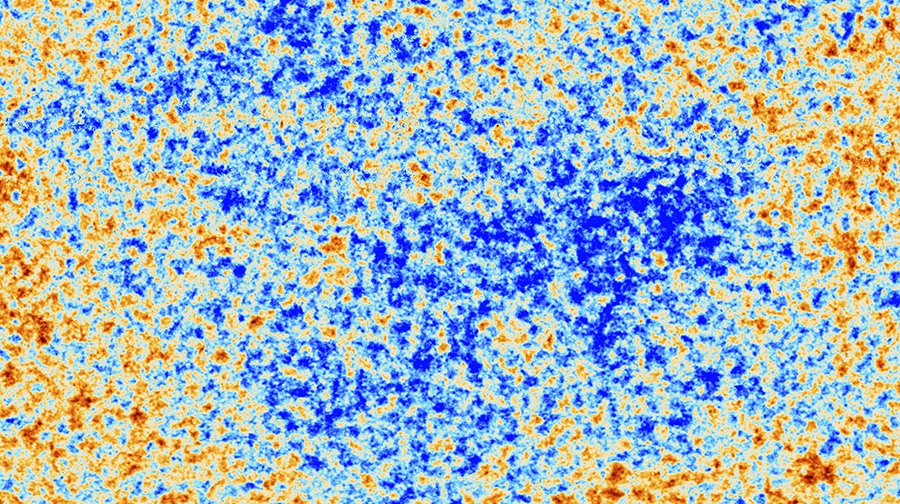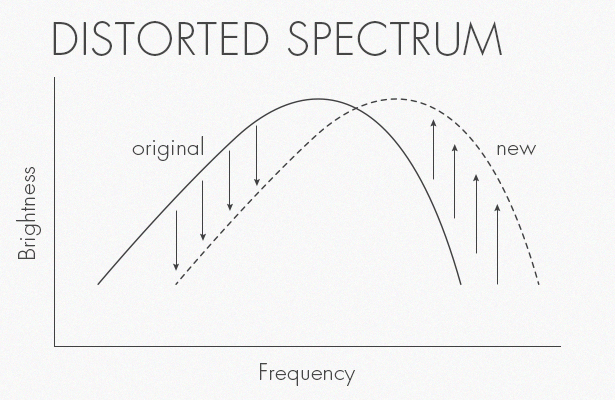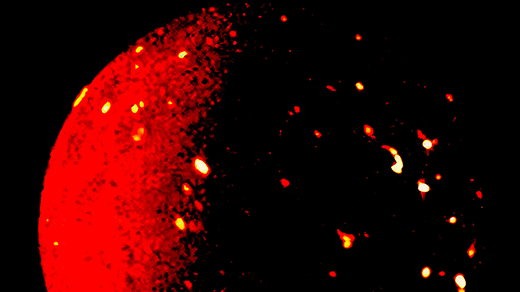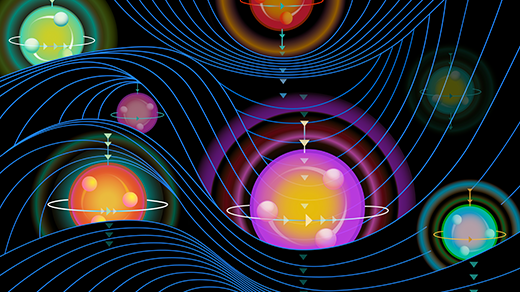Why the Big Bang’s Light May Have a Tilt

Half a century ago, astronomers got their first look at the infant universe: a haze of soft light that suffused the entire sky. This cosmic microwave background (CMB) radiation seemed to indicate that the early cosmos was remarkably uniform — a hot, dense fireball that expanded and cooled over the next 14 billion years. It was the world’s first beacon from the Big Bang.
Like a slowly developing Polaroid, our understanding of this radiation has come into focus gradually. In 1990, NASA’s Cosmic Background Explorer (COBE) satellite found that light from the CMB had the telltale spectrum of a system in equilibrium, known as a blackbody — exactly what was expected if the universe began as a dense, scalding soup of particles and photons that all interacted with one other. In addition, another instrument on COBE revealed slight hot and cold spots in the light.
Subsequent spacecraft, including NASA’s WMAP satellite and Europe’s Planck probe, have sharpened our view of the temperature variation, or anisotropy, even further. Yet measurements of the CMB’s spectrum have hardly budged in that time. At the wavelengths it studied, COBE’s measurement 25 years ago is “still the best, the gold standard,” said Jim Peebles, a physicist at Princeton University.
But more sensitive measurements should undoubtedly reveal small deviations from the blackbody curve that COBE measured. That’s because anything that injected energy into the universe after it was a few months old should have distorted this spectrum somewhat, said Alan Kogut, a physicist at NASA’s Goddard Space Flight Center in Greenbelt, Md.
“There’s a whole lot of things you can learn” from such distortions, he said.
Researchers discussed many of these prospects earlier this month at a conference at Princeton University celebrating 50 years of CMB studies. The potential revelations include details about objects both ordinary, such as stars, and exotic, such as dark-matter particles, that CMB photons might encounter on their travels through space. Even more enticingly, spectrum measurements could expose details about the first moments of the universe that no other technique could probe. A space mission called the Primordial Inflation Explorer (PIXIE), now in development, could look for these spectral distortions.
A Light Shift
The blackbody spectrum we measure today was created just a few months after the universe’s birth, when the number of photons generated in the early fireball had stabilized. “Anything that happens afterwards can distort the spectrum,” Kogut said.
For the first couple of decades after that, the universe was so dense that any process producing extra energy, such as the annihilation or decay of dark-matter particles, would affect all of the CMB photons, creating what are known as mu (µ) distortions in the blackbody spectrum. In this situation, an energetic electron produced by the demise of a dark-matter particle could transfer some of its energy to a CMB photon, “distorting the microwave background away from a blackbody,” Kogut said.
Even earlier spectral distortions might also have arisen from inflation, a short but spectacularly fast period of expansion that many researchers think occurred in the universe’s very first moments.
According to this theory, quantum fluctuations created dimples in space-time that inflation then amplified. Matter and radiation fell into these valleys, which eventually evolved into the first galaxies; the valleys explain how the chunky stew of a universe we see today emerged out of its brothlike past.
The valleys should all be of different widths, depending on when the fluctuations arose and how long they had to inflate. But leading models of inflation predict that they should all have about the same depth, since the energy scale of the inflationary field, which produced the quantum blips, is thought to have changed only slowly over time.
The matter and radiation that slid into the valleys rebounded, sloshing out and then over surrounding hills into other valleys, producing the hot and cold spots in the CMB. If no energy was lost during the sloshing, these spots would vary from the average CMB temperature by about the same amount. But some energy was lost. As the sloshing proceeded, more and more photons splashed out of the valleys. Because of this, the smallest ones, produced toward the end of inflation, no longer appear hot or cold. The effect, known as Silk damping, erases information about the depth of smaller valleys — and the energy scale of inflation at later times — in maps of the CMB’s temperature.

The energy lost during the sloshing didn’t disappear, however. It went into “heating up the universe a little bit,” Kogut said. That would have shifted the CMB’s spectrum away from a blackbody. “It basically makes the universe look a little bit bluer — a little brighter at shorter wavelengths and colder at longer wavelengths,” Kogut said.
Locating these spectral distortions could therefore reveal details about inflation on smaller scales, and later times, than is now possible. “That is information you could not get any other way,” said Simon White, director of the Max Planck Institute for Astrophysics in Garching, Germany. Measurements of the depth of the dimples at later times could test how quickly the energy scale of inflation changed, which would test competing models of the theory, Kogut said.
That’s important, said John Mather, an astrophysicist at NASA Goddard who won a Nobel Prize in 2006 for measuring the CMB’s blackbody spectrum with COBE. One of the selling points of inflation is that it seems to explain the CMB’s incredible evenness across the sky — patches of sky that are far apart would have been touching before the exponential expansion of inflation. But the CMB’s uniformity was discovered years before the theory of inflation was developed in the 1980s, and Mather said the theory would gain credibility if it made predictions that were only later found to be true. “It’s not all that powerful to predict something you already know,” he said.
Spectral measurements could also provide insight into the evolution of the universe at later times, when the universe had expanded enough that any injections of energy would be felt by only a fraction of CMB photons, producing what are called y distortions in the spectrum.
Energy from stars, galaxies and galaxy clusters should stimulate the CMB, which could help pin down the rate at which stars form and explode and at which galaxies grow and evolve, Peebles said. “There are lots of ideas about how cosmic evolution proceeded, but not much evidence,” he said. Spectral distortion measurements would offer “a rigorous constraint on what is otherwise a very slippery business.”
The $200 million PIXIE mission, which Kogut and his team are proposing to NASA for a potential launch in 2022, could search for all of these spectral distortions. With a sensitivity about 1,000 times as great as COBE, it could potentially study inflation’s dimples at a scale one-ten-thousandth of what’s possible with the CMB hot and cold spots. The mission would also search for the signature of gravitational waves from the early universe with a precision 100 times better than that of current experiments.
David Kaplan, Petr Stepanek and MK12 for Quanta Magazine; Music by Pete Calandra and Scott P. Schreer
Video: Where Did the Universe Come From? This two-minute video explores the leading explanation for the origin of the universe.
Despite its sensitivity, interpreting PIXIE’s results, should it launch, would be tricky. “Different processes … can lead to similar distortions,” said Jens Chluba, an astrophysicist at the Institute of Astronomy in Cambridge, England. “However, with precise measurements, different scenarios can in principle be distinguished.”
Kogut agrees. “The main source of confusion would be from dust in our own galaxy,” he said. However, he thinks that PIXIE can rigorously account for the influence of dust through its measurements of the sky at 400 different wavelength bands, since dust shines more brightly at certain colors than others.
“The low-hanging fruit has been gathered,” Peebles said of CMB measurements to date. Trying to detect the CMB’s deviations from a blackbody spectrum is “a very difficult measurement, but one that can be done and would teach us a lot about cosmic evolution.”
Half a century after the CMB was discovered, what can we expect in the future? Peebles is sure of one thing. “The next 50 years will be interesting.”
This article was reprinted on Wired.com.
Update July 9, 2015: Jens Chluba’s affiliation has been updated.



